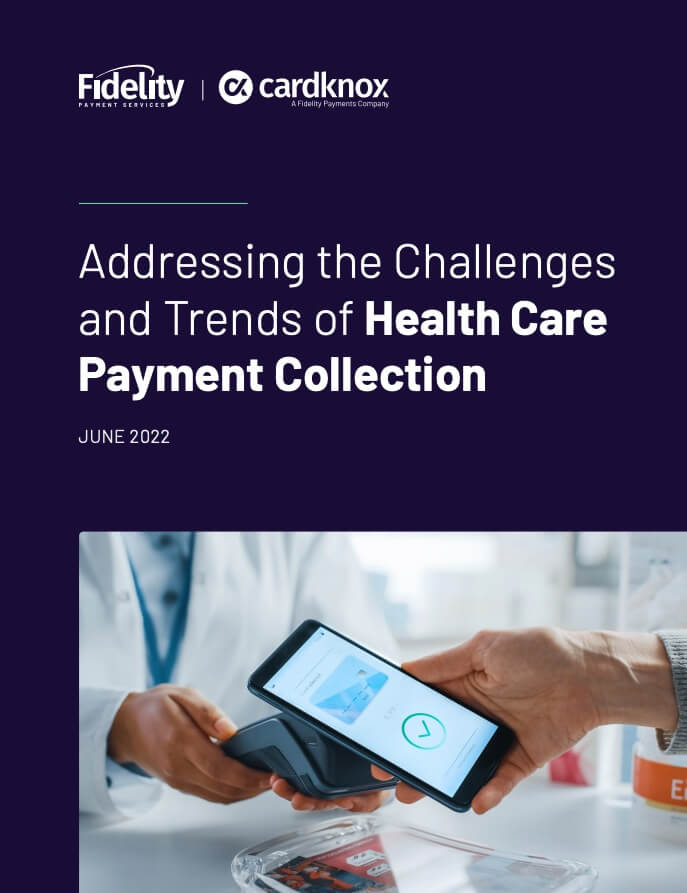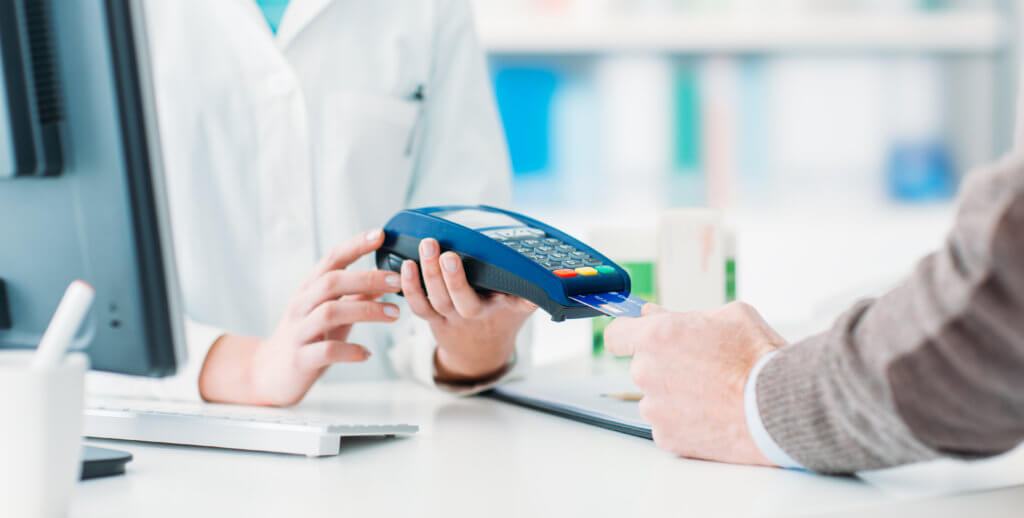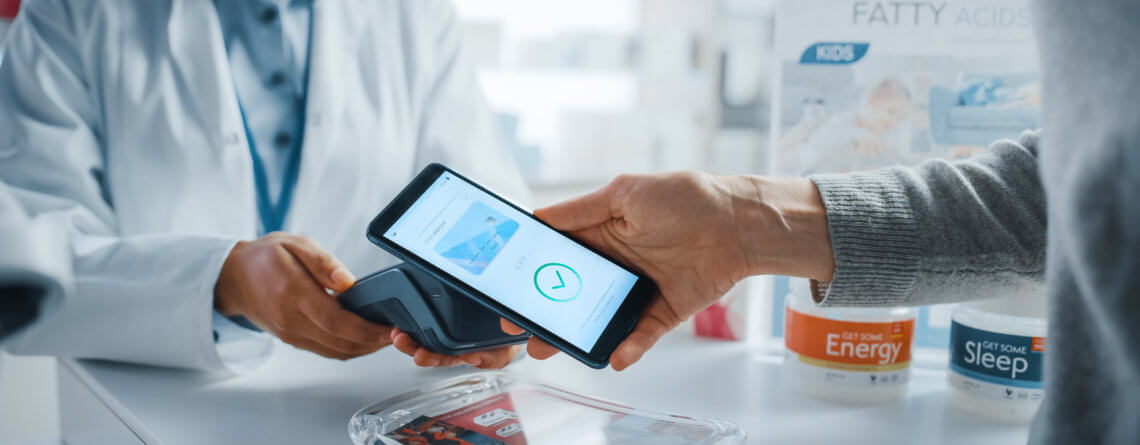Addressing the Challenges and Trends of Health Care Payment Collection
Wendy Wang2022-07-07T18:59:31-04:00Health care bill pay and collection have for many years been a pain point for patients and health care providers alike. Paper invoicing, overdue balances, and tedious account reconciliations are just some of the many challenges of traditional health care payment collection. Despite these challenges, the industry has generally been slow to adopt more modern payment collection solutions—that is, until the COVID-19 pandemic exposed the pitfalls of health care payments and spurred on health care providers to implement newer technology.
Over the past couple of years, health care organizations have rapidly shifted to digital payment processing systems. Especially as more health services are being provided remotely, medical providers have found it necessary to offer more convenient and digital ways for their customers to pay their balances.
As the COVID-19 pandemic subsides, it has become clear that the recent changes to health care bill pay and collection are here to stay. There is now tremendous opportunity not only for health care providers but also for Independent Software Vendors (ISVs) and Software as a Service (SaaS) providers to grow their revenue by catering to the latest payment preferences. In this white paper, we will take an in-depth look at the recent changes to payment acceptance in the healthcare industry and discuss how the industry can adapt with the help of the latest payment technology.

Read the full white paper anytime and anywhere.
Healthcare Industry Overview

Healthcare in the U.S. is a massive, complex industry and in fact is one of the fastest growing sectors. The industry includes not only health care providers but also a diverse range of sectors and activities such as research (treatment, drugs, devices, etc.), pharmaceutical development, drug manufacturing, medical equipment, facilities management, health care systems, and administration.
For patients, the costs of benefiting from these health care services, and others, are significant. According to CMS.gov, health care spending accounted for more than 19.7% of U.S. GDP in 2020, reaching more than $4.1 trillion in spending and an average of $12,530 per person. Spending on health care services is widely dispersed, including hospital care, physician and clinical services, retail prescription drugs, nursing and retirement care, and other health, home care, and personal care services.
As mentioned earlier, it is often a challenge for health care providers to collect everything that is owed to them. And considering that a large portion of the 907k+ businesses in the healthcare and social assistance sector are small- to mid-sized operations working within tight budget constraints, payment collection issues have the potential to be quite damaging.
Clearly, then, there are many opportunities for the healthcare system and its service providers to benefit from technology-driven efficiencies. By utilizing new payment strategies to match shifts in consumer preferences, medical service providers and health care organizations can reduce costs substantially and increase profitability.
The Role of Payments Within the Healthcare Industry
Payment processing is a core component of the overall health care experience. Considering the high costs and complexities of medical bills, it is essential that health care providers implement tools and solutions that will make bill payment more patient friendly—while also minimizing tedious labor for health care staff. Let’s start by taking a look at how payments are commonly collected by health care providers.
Medical Payment Collection Methods
Medical payments are commonly collected by health care providers in one of the following ways:
- Patient Portals
These online, self-service platforms give patients the ability to input credit card or checking account details and make a payment at their convenience. Especially when compared to the hassle of paper checks, many patients prefer the ease of making payments online. In fact, 79% of consumers in a recent survey from Instamed said they prefer to pay premiums online, compared to just 7% who want to mail a paper check.
- Check Payments
Despite the fact that nearly every health care provider accepts check payments, it is not the preferred option for them or their patients. In fact, only 10% of providers who responded to Instamed’s survey reported that they preferred receiving paper checks from payers. For patients and health care providers alike, paying with a check tends to be more time-consuming and tedious than alternative methods. Unlike electronic payment, check payments require health care staff to deposit each check and manually enter data into their system. Plus, check payment collection tends to be associated with snail-mail invoicing—a process that involves extra costs and manual labor.
- Electronic Invoices
Electronic invoices are sent to patients via email, often with a link to a secure payment form for inputting payment details. This newer bill pay acceptance solution is growing in popularity, and according to Instamed, 73% of surveyed patients would enroll in eStatements from providers. Especially as a growing number of consumers prefer to pay with credit cards rather than checks, electronic invoices are a smart solution for facilitating credit card payments. And for health care providers, electronic invoicing is a great way to automate account receivables and eliminate manual labor: payments accepted via electronic invoices can be integrated with health care management systems, which means there’s no need for data entry.
- In-Person Card Payments
Accepting card payments in person at the point of care is a common practice for health care providers, but it’s not an option when the service cost needs to be billed to insurance first. When feasible, though, in-person card processing provides major benefits: namely, there’s no need to send out an invoice, and no concern of missed or late payments. Another benefit of in-person card processing is that the hardware it utilizes can often be fully integrated with health care management software —thus syncing transaction data with patient records and invoices.
- Phone Collection
There are two main forms of phone collection for medical payments: an automated Interactive Voice Response (IVR) phone line, or a live phone line staffed by representatives who reach out to patients or field incoming calls. In the case of live support staff taking down payment details, it’s important to note that the staff must have access to a virtual terminal solution in which payment information is keyed in and processed. With an IVR line, payments are processed as soon as payment details are keyed in by the consumer.
According to a U.S. Bank Report, patients who use IVR to pay medical bills have an overwhelmingly positive experience specifically, 90% of those surveyed said that they strongly or somewhat agreed that IVR is a good way to be reminded about upcoming payments and balances due. Considering that many health care providers need to follow up more than once to obtain payment, over-the-phone payment collection is an important practice that should be taken into account when health care providers set up their payment processing system.
Inefficient Health Care Payment Acceptance Requires Solutions
A U.S. Bank report from 2021 found that nearly half of consumers felt that payments were the most difficult to complete in the healthcare industry. Spurred on by the COVID-19 pandemic, health care providers are finding that they must cater to a new set of customer preferences and economic conditions. Rising health care costs and growing demand for telehealth, among other things, are directly translating into a greater need for digitized payment acceptance options.
Drivers of Change for Health Care Payments
Let’s look at some of the key factors accelerating the transformation of health care payment acceptance:
Rising Health Care Costs
Premiums, deductibles, and out-of-pocket costs have all increased dramatically in recent years. Between 1980 and 2021, out-of-pocket costs grew by $40 to $50 every year—surging from just $250 per person in 1980 to $1,650 in 2021. As health care costs impose a greater burden on consumers, it has become even more essential for medical providers to offer flexible bill pay options, such as payment installments. Automated recurring bill pay solutions make payment installments that much easier and they reduce the incidence of missed payments.
Health care providers can also alleviate the burden of health costs by accepting a wide variety of payment methods. A patient who can’t afford to pay out-of-pocket with a check is likely to appreciate having the option to pay with their credit card, HSA (health savings account), or FSA (flexible spending account) card.
The Growth of Telehealth
Telehealth services increased 38 times from the pre-COVID-19 baseline, and 71% of consumers now expect telehealth to be an option for all visits. Health care providers that used to rely on payments made in person now know that they must offer electronic bill pay methods for their telehealth services.
Changing Patient Payment Preferences
Patients are increasingly expecting digital payment options for their health care payments. Research by InstaMed showed that 85% of Medicare beneficiaries want to make payments digitally for their medical bills and premiums, and 74% would even switch providers for a better health care payments experience. As digital methods grow in popularity, cash and check payments are falling to the wayside. In fact, although 70% of consumers in Instamed’s survey said they receive medical bills via mail, only 9% want to pay with a paper check.
So, what’s replacing cash and check payments? Patients today increasingly prefer to pay online via ACH automatic debits, credit cards, or mobile wallets. And for in-person payments, patients are opting more and more for contactless cards or mobile wallets, in addition to standard EMV chip credit cards. U.S. Bank reported in 2021 that 21% of patients increased their use of digital or contactless payments, and 70% of consumers expect digital payments to outlast COVID.

Payment Technology is the Key to Success for Health Care Providers
For health care providers that are looking to cater to the latest trends and resolve pain points with payment collection, advanced payment technology is the answer. From payment gateway integrations to advanced online billing tools, today’s solutions help health care providers streamline invoicing and add support for more bill pay channels and payment methods— thus improving cash flow. Let’s take a look at some of the benefits of cutting-edge payment technology:
- Simplified Account Reconciliation
Many health care providers have a practice management system and payment processing system that are entirely disconnected. When the two are not in sync, office personnel have to undertake the tedious and error-prone task of inputting transaction data from their payment processing hardware or software into their practice management system. This creates room for error and adds a layer of administrative cost.
An integrated system, in which the practice management system is integrated with a payment gateway, eliminates this time-consuming operational task. Instead, all transactions that are processed through an integrated system are inputted directly into the medical provider’s software. Integrated systems deliver a simplified, more accurate, and automated account reconciliation process.
- Improved Patient Bill Pay Experience
Patients like to have the choice to pay how and when they want, and in fact, providing more choice is an important way for health care providers to prevent late or missed payments. To that end, it’s essential for health care providers to work with a payment technology provider that can set them up with a wide range of payment acceptance solutions—from in-person card readers, to electronic invoicing, to check processing. By giving your patients more ways to pay, you’ll benefit from greater patient satisfaction and improved cash flow.
- Fewer Declined or Missed Payments
Missed and delayed payments are a huge challenge for medical providers. In fact, a recent survey by Instamed showed that 70% of providers took more than 30 days to collect a typical payment. Fortunately, recurring billing solutions can help. A recurring billing tool allows medical practices to collect repeat payments easily, with no need to request payment details each time. The medical practice can securely store the customer’s payment method of choice within their system, and then set up a precise recurring schedule based on the desired frequency, interval, and amount. The result is greatly reduced time spent on collections and a vastly improved client payment experience.
To reduce declined payments, many recurring billing tools have an account updater feature that regularly scans cards stored on file for any that are expired or inactive, and then automatically updates the system with the new card details. Health care providers who use this feature no longer need to worry about chasing down the customer for the correct card details.
All in all, recurring billing solutions mean greater efficiency and lower administrative and accounting costs, faster repayments and fewer late or missed payments, and greatly improved cash flow.
Cardknox Payment Solutions for Health Care Providers
Cardknox leads the industry with cutting-edge payment solutions for medical and health care providers. Health care providers can choose from a custom gateway integration, or use one of our many standalone processing solutions. All of our products offer nextlevel security with easy integrations and user-friendly interfaces that exceed your patients’ expectations and the needs of your staff. Some of our many solutions include:
Support for a Wide Range of Payment Methods
Cardknox supports today’s leading payment methods for in person and online—including credit cards, mobile wallets, FSA/HSA cards, ACH, and more. By offering support for more payment methods, you’ll be sure to improve patient satisfaction.
Software and Hardware Integrations
The Cardknox gateway is compatible with a wide range of medical practice management software as well as leading hardware options for a complete, fully-synced system. Medical providers can integrate their system with ease and choose from a wide range of compatible payment terminals—including unattended devices that are perfectly designed for self-service kiosks.
User-Friendly Virtual Terminal
For medical providers that input payment information gathered over the phone or by mail, the Cardknox Merchant Portal is the perfect solution. This online application features powerful tools for processing and managing payments. Plus, the Cardknox Merchant Portal has an electronic invoicing solution for sending email invoices, and it features transaction reporting and rich sales data.
Cardknox Mobile App
The Cardknox Mobile App is an excellent solution for on-site payment acceptance. It can be paired with a compact card reader to swipe, dip, or tap payments; or, payment data can be keyed-in manually. For a more advanced and tailored solution, Cardknox’s mobile processing features can be directly integrated into medical practice management mobile apps.
Advanced Recurring Billing & Account Updater Tools
Our user-friendly recurring payment schedules tool, available in the Cardknox Merchant Portal, allows medical providers to set up precise recurring schedules that process payments automatically. And to prevent declined transactions, our Account Updater tool automatically locates and updates expired or inactive cards stored within the system.
Easy Online Invoicing
Cardknox’s online payment form, PaymentSITE, is fully customizable and can be embedded into a webpage or shared via its URL to collect payments. It supports a wide range of payment methods, including credit cards, mobile wallets, ACH, and even cryptocurrency. Users of the Cardknox Merchant Portal can easily customize their PaymentSITE and send it out via email with just a few clicks.
Start Reaping the Benefits of Powerful Payment Technology
Whether you’re a health care clinic, developer, or ISV, investing in new digital payment solutions is the way to increase patient loyalty, benefit from efficiencies and cost savings, and grow profitability. Contact us today to learn more about our payment solutions for the healthcare industry, as well as our profitable Cardknox Partner Program for ISVs and resellers.

Read the full white paper anytime and anywhere.


